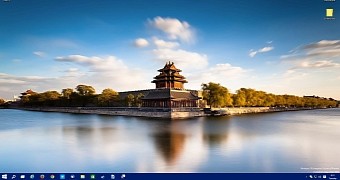Just like it happened when Windows 8 came out in October 2012, Microsoft expects an avalanche of products running Windows 10 to see daylight later this year, after its new operating system comes out, so there are plenty of questions regarding the way the new product would work on these devices.
Microsoft's Joe Belfiore has revealed in a tweet that the desktop side of Windows 10 will be available only on devices with a display of 8 inches or larger, while those with a smaller screen will have to stick to the Modern UI.
In a follow-up tweet, Belfiore has also added that those with 7-inch tablets will also be provided with a desktop, but he has only referred to existing devices powered by Windows 8.1, so it's not clear what exactly is going to happen with new tablets and phablets with a screen this size.
Revamped Modern UI in Windows 10
Microsoft's decision to make the desktop exclusively available on devices with larger screens pretty much makes sense, especially because it would be really difficult to work on the desktop on a device with a 7-inch display.
But in order to tackle the lack of a desktop, Microsoft tried to revamp the Modern UI in a way that would make it more productive, so the Start screen now looks and feels similar to the Start screen, while Modern apps are getting new options that make them easier to use with touch.
What's more, Microsoft is also bringing the Office productivity suite in the Metro side of its operating system, so those relying exclusively on touch will also be allowed to edit documents, spreadsheets and presentations with ease.
Windows 10 build 9926 already comes with an early version of Continuum, the feature that allows 2-in-1 PC owners to toggle between the desktop and the Modern UI when removing the keyboard from their devices.
Improvements will be shipped in future updates, Microsoft has promised, so the Modern UI is set to become even better before the final version of Windows 10.
@marypcbuk @jackschofield @ExNokian @sbisson @dinabass 8" & up = "desktop" w/ win32 apps. < 8" = phones, phablets, sm tablets. No dsktp.
— joebelfiore (@joebelfiore) January 26, 2015
Folks asking about updating 7" *existing* devices to Win10 -- you keep your desktop, you get continuum. Go try it yourself now! :)
— joebelfiore (@joebelfiore) January 27, 2015

 14 DAY TRIAL //
14 DAY TRIAL //